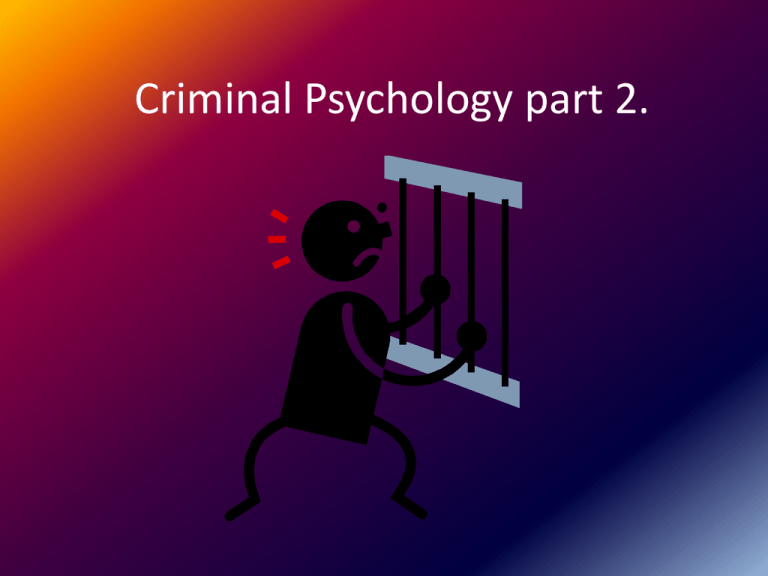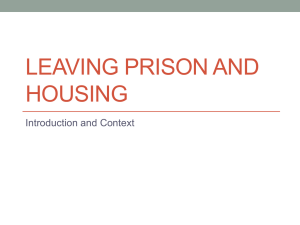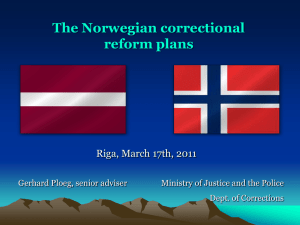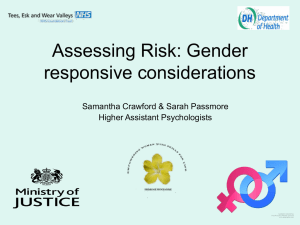Powerpoint Pres - VirtualPsychology
advertisement

Criminal Psychology part 2. Raine( 1997) –Brain Dysfunction & Criminality. • Normal Murderer • ACTIVITY DEFICIT Raine's PET scans show greater activity (red regions) in the prefrontal cortex of a normal brain than in a murderer's brain. • • Used PET scans to illustrate murderers showed reduced glucose metabolism in the prefrontal cortex, superior parietal gyrus & corpus Callosum. • Along with asymmetrical activity in the two hemispheres. • This supported a link between brain dysfunction and a predisposition to violent acts. Daly & Wilson (1988) • Fitness variance between males and females. • Basically: Women are fairly successful with breeding and men not so much, therefore there is higher rate of competition- this may lead to increased aggression and this increase could possibly account for the number of murders being committed by men than by women. • Men do not back down due to ‘male pride’ & the desire to impress a potential mate. Social learning theory. • Bandura – Behaviour is learned through observation. The said behaviour is then imitated by the child/other and taken on as a normal behaviour. • http://www.youtube.co m/watch?v=vdh7Mngnt nI • COULD THIS BE THE ANSWER TO CRIMINALITY? Hold a minute...what role do family play? • Farrington et al suggested disrupted home life could be the key. • 411 Ps (8&9 years old working class area of inner city London. • Using questionnaires, interviews (of both parent and child!) • Findings: 41% criminally convicted between 10 & 50 years old. • Early offence= more offence. • Risk factors= family criminality low school attainment poverty and poor parenting. • Conclusion: Aspects of upbringing contribute to delinquent behaviour in later life. Further research!!! • Sutherland • The belief that deviant behaviour is learned from peers. • Not just techniques and methods are learned...but motives and attitudes too. • This was called the differential association hypothesis • Loeber • Delinquency appears to develop in young males. • That socio-economic factors e.g. Poverty and personal attributes such as IQ put young boys at risk of delinquency. • His research Pittsburgh Youth study (2002) supported this hypothesis. What is your view? • http://www.telegraph.c o.uk/news/uknews/cri me/7432303/JamieBulgers-killers-weretoo-young-to-be-triedfor-their-crimes-saysChildrensCommissioner.html • http://www.youtube.co m/watch?v=MpdPGhL8 haA&feature=youtu.be &a Q: Who are the victims - Jamie, Jon, Robert, or all of them? What is the answer to ensure criminals do not re-offend? • Firstly Recidivism (fancy word for repeating antisocial behaviour after you have been punished..in essence re-offending) is based upon a number of factors: • In pairs can you note down some of the factors you believe to be influential.... Factors unveiled...... • • • • • • • Length of time spent in prison Supervision after release Disciplinary reports Education level Seriousness of crime Prisoner ethnicity Individual experiences in prison. Furthermore • There has also been research to support the theory that employment can have an influencing effect on reoffending. • Gillis et al (2001) offenders who found employment within 6 mths of release had fewer convictions than offenders who did not find employment. • (Cautionary note: must keep in mind cause & effect) Rehabilitation for offenders. • • • • • • • • Prison Probation Restorative justice Death penalty Token economy Anger management Cognitive skills programming Acupuncture Prison • • • • • Dooley (1990) METHOD: Case notes from 295/300 suicides within prison 1972-1987. RESULTS: Prisoners serving life or convicted of violent/sexual offences most at risk. • Association between suicide and guilt • History of psychiatric problems in 1/3 of cases and self harm...very common. • CONCLUSIONS: • Depressive illness likely to contribute to suicides in prison. • Better communication between guards and prisoners would reduce suicide risk. Prison cont... Zimbardo prison study: guards emotional distress sadistic situational vs. Dispositional Prisoner How did the study inform prison reform? • • • Rehabilitation is not a major consideration People being imprisoned for longer periods Less access to training, education & counselling for prisoners. In short they did not inform policy , Zimbardo et al suggested 1. 2. 3. 4. Prisons are potentially damaging (Psychologically) People can be transformed, play to their roles, therefore they are likely to be effected by a change in situation after they ae released. Programmes are needed to prepare prisoners for their new situation and roles outside of prison. This will lead to lower rates of recidivism than harsher conditions and longer sentences. • What do you think???? Can probation be the key?? Probation is usually used as an alternative to prison or after release. It can include: • Abiding to curfews • Living in agreed accommodation • Wearing a tag • Supervision by a probation officer. • Drug rehabilitation. Is this effective? • The aim is to punish by making the individual pay for their crimes by limiting their ability to commit further crimes.. • Each offender is dealt with individually and a comprehensive treatment plan is put into place to help the offender get over their problems and not reoffend. Prison reform trust 2003 Offenders should only face prison for serious crime that could not be dealt with in community. Findings of Trust!! 1. UK prison population is growing because courts are tending to impose more longer prison sentences rather than using community penalties. 1. Not due to lack of community options-most happy with options available through probation service..but it is underfunded. 1. Prison should be last option. Better information should be available about community options. How about restorative justice. RESTORATIVE JUSTICE?? 1. The victim must volunteer to use approach-the offender must have admitted to offence. 2. Face-face meeting or by letter. 3. Can involve undoing damage: remove graffiti. ADVANTAGES 1. It can reduce PTSD, less likely to seek violent justice. 2. Criminal and victim more satisfied with outcome vs traditional justice solutions. 3. Decrease costs' Death Penalty? SUPPORTERS 1. Acts as a deterrent 2. Punishment matches the crime 3. Families of murder victims deserve to see murderer suffer. CHALLENGERS 1. DNA- Some has proven people innocent of crime. 2. More expensive to execute than keep alive 3. Not applied fairly & discriminates against minorities and poor. Is token economy the key????? Rewards for reaching goals: Conditions that are established: 1. 2. 3. 4. Clearly defined behaviour. Reasons for tokens....clear! Currency of token...clear! Rate of earning clear! Can this really work? Based upon the behavioural principle of operant conditioning: No..anger management will do it! Therapeutic programme. 1. 2. 3. 4. 5. The assumption is violent behaviour is caused by anger/frustration Control of this will reduce these violent behaviour patterns. Using CBT & specific programmes for use in penal system. The aim is to improve awareness and control..it is hoped it will make a difference after prison. 2-hour sessions over eight weeks. Q: Can this have the long-term positive effects? A: According to Ireland (2000)..yes! A range of rehabilitation treatments have been used with these individuals/victims. Let us review!! Police had voiced concerns that he would re-offend but lack of resources meant he could not be placed under 24-hour Born evil? Not given appropriate assistance He is alleged to have attacked a woman in her 70s in a central London street earlier this month, attempting to rape her and stabbing her in the hands and face http://www.bbc.co.uk/blogs/haveyoursay/2010/03/how_can_we_reduce_reoffe nding.html http://www.dailymail.co.uk/news/article-562120/Serial-rapist-attackspensioner-months-deported-Britain-Australian-jail.html#ixzz0iABcKTZU








